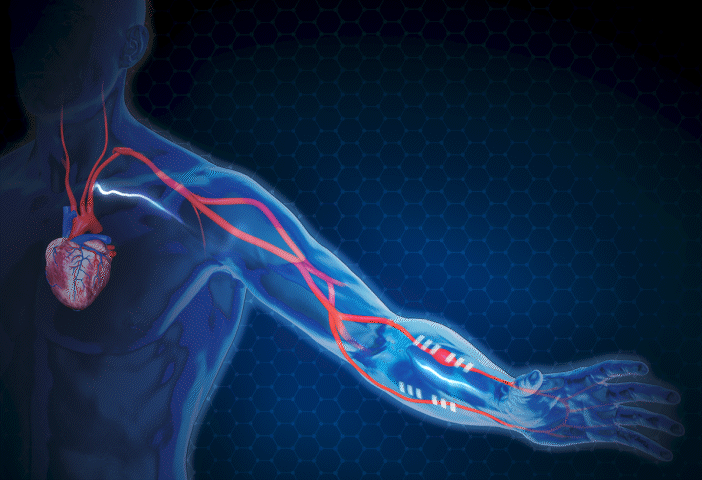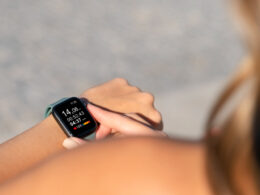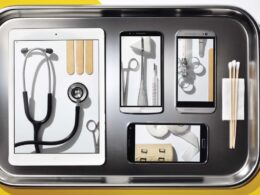health transformation institute (HTI)
the most comprehensive knowledge portal, for health transformation
Joaquim Cardoso MSc*
Founder, Chief Researcher and Editor
November 28, 2022
MSc* from London Business School — MIT Sloan Masters Program
ORIGINAL PUBLICATION

Temporary “tattoos” that measure blood pressure
National Institute of Biomedical Imaging and Bioengineering (NIBIB)
November 28, 2022
Peel-and-stick device could pave the way for remote monitoring
Blood pressure is a key vital sign that provides insight into our cardiovascular health.
But blood pressure is typically measured only a few times per year by a clinician-and these measurements might not always be accurate (maybe, for instance, you’re nervous at the doctor’s office).
A wearable device that could monitor blood pressure continuously would provide more informative readings, allowing clinicians to observe trends and detect consequential blood pressure changes, ultimately improving heart health.
Nearly a decade ago, in collaboration with the Indian government, NIBIB spearheaded an international effort to develop a wearable cuffless system.
Building on years of research, scientists are now fine-tuning such a device.

Made of graphene, one of the thinnest materials in the world, the device is worn on the underside of the wrist and can measure blood pressure with comparable accuracy to a standard blood pressure cuff.
While the technology is still in its early stages, the researchers envision that the monitor will be worn 24/7.
The device was recently described in Nature Nanotechnology.
Made of graphene, one of the thinnest materials in the world, the device is worn on the underside of the wrist and can measure blood pressure with comparable accuracy to a standard blood pressure cuff.
While the technology is still in its early stages, the researchers envision that the monitor will be worn 24/7.
“The blood pressure monitor was developed in the late 19th century, and the core technology has not seen significant changes,” explained Tiffani Lash, Ph.D., a program director in the Division of Health Informatics Technologies at NIBIB.
“Unlike traditional blood pressure cuffs, this device could enable continuous and unobtrusive monitoring, which could pave the way for remote, round-the-clock evaluation of blood pressure.
As cardiovascular diseases are the leading cause of mortality worldwide, such a device has the capacity to mitigate potentially preventable deaths.”
“Unlike traditional blood pressure cuffs, this device could enable continuous and unobtrusive monitoring, which could pave the way for remote, round-the-clock evaluation of blood pressure.
As cardiovascular diseases are the leading cause of mortality worldwide, such a device has the capacity to mitigate potentially preventable deaths.”
At first glance, the blood pressure monitor looks like a temporary tattoo-the graphene and the tiny components inside resemble small, transparent stickers, which adhere directly to the skin.
The application is even similar: place the device-which is attached to a thin strip of paper-onto the skin, dampen the paper with water, and gently remove the paper, leaving the blood pressure monitor behind.
At first glance, the blood pressure monitor looks like a temporary tattoo-the graphene and the tiny components inside resemble small, transparent stickers, which adhere directly to the skin.
The application is even similar
Similar ‘electronic tattoos’ have been investigated before, but they typically employ metal films that do not conform perfectly to the skin, explained study author Deji Akinwande, Ph.D., a professor at The University of Texas at Austin.
“With prior devices, there’s a lot of sliding between the metal film and the skin, leading to motion artifacts that can mask the real signal that we’re trying to capture,” he said.
“Because graphene is so thin and flexible, it doesn’t suffer from motion artifacts, and we can capture precise measurements for an extended period of time.”
Similar ‘electronic tattoos’ have been investigated before, but they typically employ metal films that do not conform perfectly to the skin, …“Because graphene is so thin and flexible, it doesn’t suffer from motion artifacts, and we can capture precise measurements for an extended period of time.”
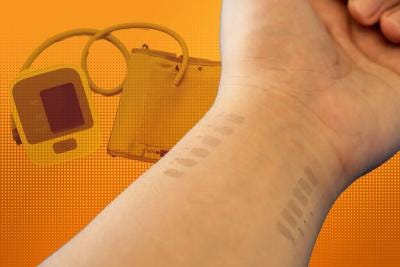
The tattoos don’t measure blood pressure directly, like traditional monitors do.
Instead, the tattoos rely on bioimpedance-a measure of how the body resists an electrical current.
The tattoos contain tiny electrodes that apply a small current to an artery in the wrist and then sense how that current is affected by the artery.
These bioimpedance measurements can then be converted into blood pressure readings using machine learning.
The tattoos don’t measure blood pressure directly, like traditional monitors do.
Instead, the tattoos rely on bioimpedance-a measure of how the body resists an electrical current.
The researchers evaluated their bioimpedance tattoos in seven healthy individuals.
On average, each participant was continuously monitored for about four hours, resulting in roughly 2,000 measurements per participant.
Participants performed various exercises to intentionally raise their blood pressure, such as completing hand grip exercises, peddling on a stationary bike, or performing the Valsalva maneuver (when one attempts to forcefully exhale when their mouth is closed and their nose is pinched shut).
During these experiments, participants also wore a medical-grade blood pressure monitor to provide reference blood pressure measurements-and the researchers found that their bioimpedance tattoos could determine participants’ blood pressure with high accuracy.

Using the gathered data, the researchers built machine learning algorithms so that the bioimpedance tattoos could be used to calculate blood pressure for circumstances beyond those evaluated in their experiments.
Participants were then invited to perform additional activities-like walking or engaging in strenuous exercise (such as an extensive, sweat-inducing outdoor walk or pushups).
Following these activities, the researchers evaluated blood pressure readings (which are taken when participants are stationary).
While the bioimpedance tattoos could withstand exposure to light, heat, water, or sweat, their blood pressure accuracy decreased slightly during post-exercise monitoring.
The researchers will continue to incorporate additional data, including higher blood pressure measurements induced by exercise, into their machine learning algorithms-which should enhance their accuracy.

The researchers also envision further optimization of their device so that the blood pressure data could be wirelessly transmitted.
As of now, the tattoos require connection to external equipment using thin gold wiring, which enables a blood pressure readout.
“This first-generation device is still in its early stages, but the promise of this technology is that it could literally be worn at all times and provide a wealth of biophysical data,” said study author Roozbeh Jafari, Ph.D., a professor at Texas A&M University and lead author on the NIBIB grant.
“Blood pressure and hypertension are tied to serious and life-threatening health conditions, and the ability to monitor this vital sign continuously could inform proactive interventions that could improve public health.”
The researchers also envision further optimization of their device so that the blood pressure data could be wirelessly transmitted.
As of now, the tattoos require connection to external equipment using thin gold wiring, which enables a blood pressure readout.
And as research indicates that blood pressure levels have increased during the pandemic, finding ways to monitor blood pressure continuously, especially among those with hypertension, may become increasingly important.
… research indicates that blood pressure levels have increased during the pandemic, so, finding ways to monitor blood pressure continuously, especially among those with hypertension, may become increasingly important.
This study was supported in part by a grant from NIBIB (R01EB028106). Other funding sources include the Office of Naval Research (grant N00014–18–1–2706) and the National Science Foundation (grant 1738293).
Study reference:
Kireev, D., Sel, K., Ibrahim, B. et al. Continuous cuffless monitoring of arterial blood pressure via graphene bioimpedance tattoos. Nat. Nanotechnol. 17, 864–870 (2022). https://doi.org/10.1038/s41565-022-01145-w
Originally published at https://www.nibib.nih.gov.
REFERENCE PUBLICATION
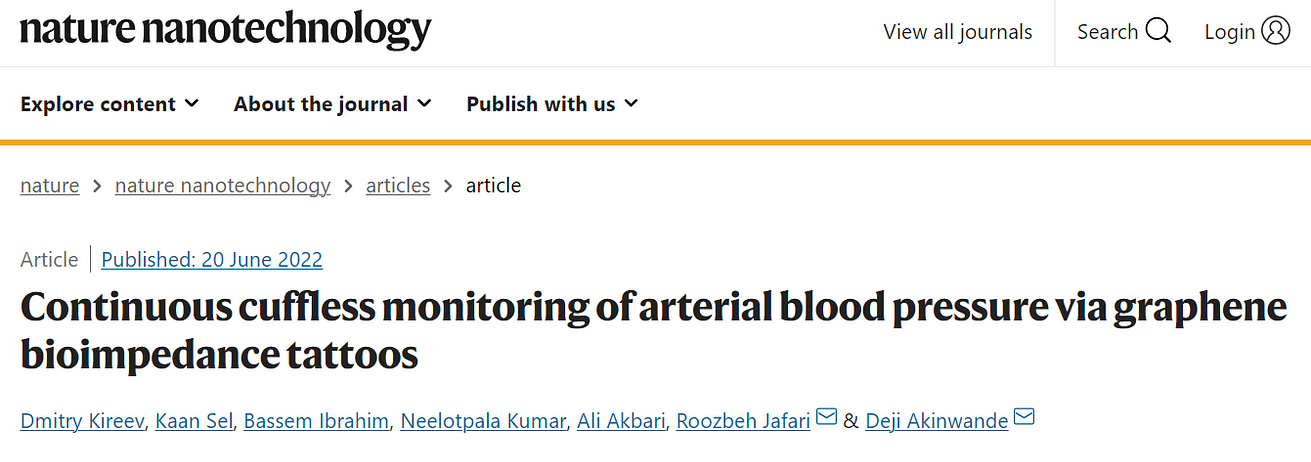
Continuous cuffless monitoring of arterial blood pressure via graphene bioimpedance tattoos
Dmitry Kireev, Kaan Sel, Bassem Ibrahim, Neelotpala Kumar, Ali Akbari, Roozbeh Jafari & Deji Akinwande
Abstract
- Continuous monitoring of arterial blood pressure (BP) in non-clinical (ambulatory) settings is essential for understanding numerous health conditions, including cardiovascular diseases.
- Besides their importance in medical diagnosis, ambulatory BP monitoring platforms can advance disease correlation with individual behaviour, daily habits and lifestyle, potentially enabling analysis of root causes, prognosis and disease prevention.
- Although conventional ambulatory BP devices exist, they are uncomfortable, bulky and intrusive.
- Here we introduce a wearable continuous BP monitoring platform that is based on electrical bioimpedance and leverages atomically thin, self-adhesive, lightweight and unobtrusive graphene electronic tattoos as human bioelectronic interfaces.
- The graphene electronic tattoos are used to monitor arterial BP for >300 min, a period tenfold longer than reported in previous studies.
- The BP is recorded continuously and non-invasively, with an accuracy of 0.2 ± 4.5 mm Hg for diastolic pressures and 0.2 ± 5.8 mm Hg for systolic pressures, a performance equivalent to Grade A classification.
Names mentioned
Tiffani Lash, Ph.D., a program director in the Division of Health Informatics Technologies at NIBIB.
Deji Akinwande, Ph.D., a professor at The University of Texas at Austin.
Roozbeh Jafari, Ph.D., a professor at Texas A&M University and lead author on the NIBIB grant.




